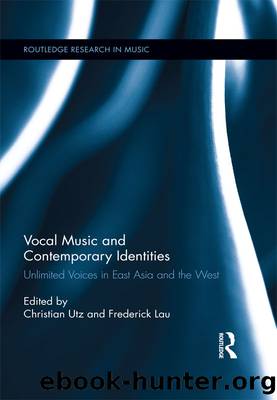Vocal Music and Contemporary Identities by Utz Christian;Lau Frederick;

Author:Utz, Christian;Lau, Frederick;
Language: eng
Format: epub
ISBN: 1108543
Publisher: Taylor & Francis Group
EXPLORATION OF NEW POSSIBILITIES IN VOCAL MUSIC AFTER 1950
Some accounts generalize the postwar musical avant-garde as anti-expressive, entailing a ban placed on great passions and a lack of interest in vocal design. This, however, is an overly simplified perspective, though it is obvious that (and why) the first serial works were conceived for purely instrumental or electronic settings. But countertendencies as well as conceptual diversification and extension were an intrinsic part of the musical avant-garde during this period. From the middle of the 1950s onwards an explicit interest in vocal music developed within the context of serial music. And it seems that this interest was not least due to auratic and expressive qualities that were represented by the vocal mediumâqualities that also symbolized a subversive and uncontrollable element opposed to serialist construction.
This tension is a key to the paradoxical as well as fascinating situation of well-known vocal works from the 1950s such as Karlheinz Stockhausen's electronic composition Gesang der Jünglinge (1955/1956), Luigi Nono's Il canto sospeso (1955/1956), or Le marteau sans maître (1953/1955, revised 1957) by Pierre Boulez. In these works the auratic component of singing competes with a strictly conceived musical structure as it were. In Boulez's work for alto and six instrumentalists this results in a peculiar type of impersonal artificiality that led György Ligeti to speak of a âsensual feline worldâ (Ligeti 1960, 62). In Stockhausen's work this situation gave rise to a characteristic naivety which divided the reception of Gesang der Jünglinge into gleaming support and rigorous repudiation. Building on the same dialectics between aura and structure, Nono achieved a new connection between an unsettling content and a kind of musical expression that balanced pathos and aesthetic distance.
Surely all three composersâand many more could be named hereâ aimed at a strict negation of stereotypes of expression from the classical-romantic tradition. Even more important though, these composers were striving for their own language in the deepest sense, for creating moments of incommensurable expression.
Of course it would be possible to argue that such works eliminated the kind of emotionality commonly attributed to voices. Obviously this was how composers such as György Ligeti, Luciano Berio, or Mauricio Kagel felt when, from the late 1950s onwards, they created works that aimed at a radical liberation of vocal expression, producing fancy theatrical effects. These works, among them Berio's TemaâOmaggio a Joyce (1958), Ligeti's Aventures/Nouvelles Aventures (1962â1965), or Kageľs Anagrama (1957â1958), are equally innovative, pursuing, however, an opposite intention. Their eccentric outbursts are not unsimilar to what can be found in some special forms of the Italian Renaissance madrigal, while their strong tendency to âdesemanticizationâ is historically unique (cf. Klüppelholz 1995).
Non-semantic vocal composition can be differentiated by isolating two principal tendencies. The first tendency, preshadowed by Stockhausen's Gesang der Jünglinge, desemanticized a given text, for example by dissolving it into phonemes. Many composers agreed that this technique functioned particularly well when the text was widely known or presented in its original form simultaneously, e.g., in a program book, or within the composition itself.
Download
This site does not store any files on its server. We only index and link to content provided by other sites. Please contact the content providers to delete copyright contents if any and email us, we'll remove relevant links or contents immediately.
Papillon by Henry Charrière(796)
Watercolor With Me in the Forest by Dana Fox(590)
The Story of the Scrolls by The Story of the Scrolls; the M(556)
This Is Modern Art by Kevin Coval(459)
A Theory of Narrative Drawing by Simon Grennan(456)
Frida Kahlo by Frida Kahlo & Hayden Herrera(445)
Boris Johnson by Tom Bower(443)
Banksy by Will Ellsworth-Jones(435)
AP Art History by John B. Nici(429)
Van Gogh by Gregory White Smith(426)
Draw More Furries by Jared Hodges(423)
The Art and Science of Drawing by Brent Eviston(423)
Glittering Images: A Journey Through Art From Egypt to Star Wars by Camille Paglia(420)
War Paint by Woodhead Lindy(414)
Scenes From a Revolution by Mark Harris(413)
100 Greatest Country Artists by Hal Leonard Corp(392)
Ecstasy by Eisner.;(386)
Young Rembrandt: A Biography by Onno Blom(374)
Theater by Rene Girard(355)
